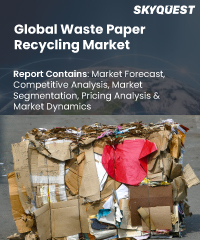
Report ID: SQMIG15Q2003

Report ID:
SQMIG15Q2003 |
Region:
Global |
Published Date: April, 2024
Pages:
184
|
Tables:
63 |
Figures:
75
Waste Paper Recycling Market size was valued at USD 44.82 Billion in 2023 and is poised to grow from USD 46.75 Billion in 2024 to USD 65.47 Billion by 2032, growing at a CAGR of 4.3% during the forecast period (2025-2032).
The demand and consumption of paper products are increasing worldwide because increasing number of colleges, education institutes, and industries across the world. The main raw material used for manufacturing paper is wood and bamboo, that's why the demand for wood and bamboo is increasing. Increasing demand for paper leads to a rise in deforestation. For preventing the rise in deforestation there is a need for waste paper recycling.
Due to the increasing urbanization and the rise in literacy rates in middle-class populations in developing economies, recycling of paper is becoming extremely important in modern life. Paper recycling is becoming more popular due to the increasing concern over depleting environmental resources. The recovered paper provides more than 35% of the paper raw material requirements in countries like India and China. Due to a shortage of waste paper collection and segregation systems, India imports a lot of recovered paper to fulfil its domestic need.
Local players concentrate primarily on establishing proper collection and segregation facilities to promote waste paper collection. Leading recycling companies are creating automated, highly effective recycling systems to lower production costs and minimize labour-intensive tasks by automating the process. Waste papers come from a variety of sources, including thrown-away, paper mill wastes, and papers that are discarded after being used by consumers. Old newspapers, magazines, cardboard boxes, wrapping paper, and packing paper are just a few examples of the waste paper that can be recycled and reused. The advantages of waste paper recycling are saving energy, wood, and water which influence the growth of the waste paper recycling market. Waste paper recycling reduces greenhouse gas emissions, and recycled fibre is a sustainable, cost-saving resource for making new paper products. The use of recycled paper represents a substantial investment in reducing the demand for wood, electricity, and pollutant emissions during the initial pulping process. According to the World Wildlife Federation, recycling one ton of used paper can yield 800 kg of raw recycled fibre, saving 17 trees. Recycled paper also reduces carbon emissions from combustion.
US Waste Paper Recycling Market is poised to grow at a sustainable CAGR for the next forecast year.
Our industry expert will work with you to provide you with customized data in a short amount of time.
REQUEST FREE CUSTOMIZATIONWant to customize this report? This report can be personalized according to your needs. Our analysts and industry experts will work directly with you to understand your requirements and provide you with customized data in a short amount of time. We offer $1000 worth of FREE customization at the time of purchase.

Report ID: SQMIG15Q2003